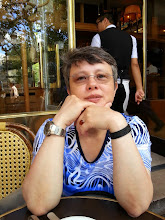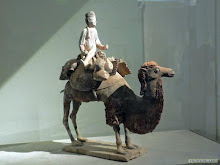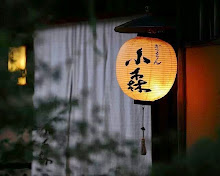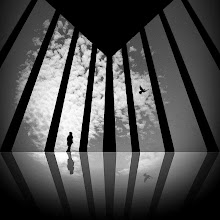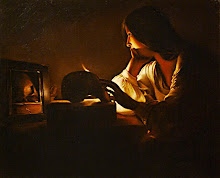"The Raven", 1971, David Inshaw, Oil on Canvas, 35 x 48 cm, Red Rag Gallery, Stow on the Wold, UK
“Go, go, go, said the bird: human kind
Cannot bear very much reality.
Time past and time future
What might have been and what has been
Point to one end, which is always present.”*
Scattered pieces of time, scattered pieces of life. Down the lawn, among the tall hedges and the nipple- like copses. There were evenings full of passionate love, of laughter, of an overwhelming feeling of gratefulness. Evenings spent naked in the outdoors, by the lake, loving each other for a lifetime it seemed. Life with her. No more. No more celebration of nature, of being alive. Still, point. Everything caught and held in a place now beyond our reach. Our time turned into past time. And what of Munnin, the black-hearted, in the sorrow likeness even now? Muninn the raven.
In “The Raven”, 1971, British painter David Inshaw (1943), offered us an intriguing painting. It was created at the time of the artist's involvement with his then muse, Gillian Pollard, with whom Inshaw would experience a troubled relationship. It was also during that same year, that Inshaw moved to Devizes, in Wiltshire. Looking at “The Raven”, it is hard to decide whether or not it is a landscape painting or a portrait. Obviously, its small format would have us opt for the latter. But is it that simple?
Tracing back Inshaw's work during the next three or four years, we realize that, with paintings like “The Badminton Game”, “She Did Not Turn” and “The Raven”, Inshaw's muse had become a symbolic figure for a mixture of complex feelings. Feelings for the woman, for the beauty seen in nature, for the Wiltshire landscape, in particular, all inextricably entwined. Let us now look closer at “The Raven”. What do we see, beyond the obvious atmospheric and sensual setting? Beyond the apparently seamless surface of the canvas?
First, a beautiful and sensuous woman, seated in a rattan chair, barefoot and casually clad with a red turned-up dress. At her feet, a black raven stands still, its gaze towards something outside the pictorial space. The woman too is staring in the same direction, her chin resting upon her left hand. Strangely enough, although staring at something invisible to us, the woman's attitude is somewhat absent-minded.
She is neither with us nor with the painter. Perhaps, her pensive and detached mood, as an omen to what was yet to become of their relationship? In the topiary garden, the tall dark hedges, the copses in the front row form a natural barrier which is duplicated in the picture background, down by the lake. The brooding sky, the shadows on the ground, even the lake itself, all contribute to a feeling of confinement. The densely foliated garden – a recurrent theme in Inshaw's œuvre – almost a dreamlike scene, suffused with feelings of helplessness before the passing of time.
“This is the first thing we have lost
The hands of the clock
the shadows on the grass
and the smell of the rain
into the sultry air.”**
While “The Raven” is a painting redolent with the sense of time lost, it is also a celebration of life, of all the passionate richness nature can give us. Following the footsteps of Thomas Hardy's use of the landscape as a metaphor for human feelings, Inshaw often painted it as an embodiment of his own sexuality. Although clearly aloof and somewhat melancholic, the woman with the raven at her feet is still very much an object of desire. This is a highly charged moment of time, under the dark and lowering clouds, into the topiary garden. One can almost feel the physical tension that permeates the painting. The apparent stillness of the characters, as a pictorial mean to express the intensity of the painter's inner life.
This is Inshaw's vision of time, both recollected and imagined. Soon, the woman will be gone, leaving an empty chair in an empty garden. Perhaps, she listened to Muninn, the raven? Perhaps, she too realized that there are paths never to be trodden, memories never to have taken place? It is also possible that “The Raven”, was Inshaw's way of dealing with loss. Although the whole painting is very controlled in its making, everything else is not. The pervasive sense of foreboding and pessimistic mood is undoubtedly lessened by an overwhelming appetite for life. The life that was never lived, like an intoxicating dream, the warmth and the softness of a woman's body, the ebb, and flow of time. Time that was. Time that might have been.
“Other echoes
Inhabit the garden. Shall we follow?
Quick, said the bird, find them, find them
Round the corner. Through the first gate,
Into our first world, shall we follow
The deception of the thrush? Into our first world.”***
*“Burnt Norton”, (1934) in “Four Quartets”, by T.S. Eliot (1888-1965)
** Poem by Ariane Kveld Jaks
*** “Burnt Norton”, (1934) in “Four Quartets”, by T.S. Eliot (1888-1965)

